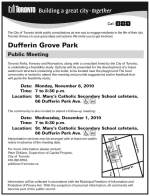Comments?
For the basics, see
- Website & Privacy Policies
- How To Get Involved
- The Role of the Park
Search options:
Department Site Map
Custodians:
 Biotoilet News 2010
Biotoilet News 2010
Biotoilet News 2010
Park bio-toilet meeting, Monday November 8, 7 - 8.30pm, St.Mary's High School
In summer 2010, the Capital Projects section of Parks, Forestry and Recreation contracted a consultant to do a feasibility study, working with Georgie Donais, for reviving the bio-toilet project. Two public meetings are scheduled to discuss the consultant's proposals: November 8 and December 1.
The $8000 never-used donated bio-toilet is in storage and ready to install. Considering the standard price tag for a park toilet: $600,000 – and the price tag for the Exhibition Place rainwater-flush-toilet pilot project (over $900,000) – the bio-toilet seems a pretty good pilot project for public places where money is scarce but people still need a toilet.
From the September 2010 Newsletter:
4. Whatever happened to the bio-toilet?
It’s been stalled since the last election. Too much broken-telephone under the previous Parks management made progress impossible. However, a recent CELOS project of following up Stimulus Fund playground replacements meant we visited parks all over the city. Many sizeable parks have no public toilets at all! Chemical toilets sometimes take their place, but most park users avoid them, preferring the bushes. That reopened the question for CELOS: could modern, clean, industrial-size composting toilets help make parks more user-friendly without breaking the city budget?
Local architect/building designer Rohan Walters was willing to work on a new feasibility study (i.e. detailed schematic plans, also involving engineer consultants) with builder Georgie Donais. The Parks Capital Projects section was willing to give them a contract for such a study. Done! The work has begun, and it will involve lots of community learning and discussion. Bonnie Burgess, who lives near Dufferin Grove, had many detailed objections the last time around. A request has gone to her to share those objections now, so that they can be useful to the study. In mid-September, Rohan and Georgie will begin to post bio-toilet material on the green-shed bulletin board near near the playground. All contributions are welcome! It should be an interesting study, also involving many inevitable puns. More fun than last time.....
From the June 2010 Newsletter:
A PLAYGROUND TOILET
Four years ago, Georgie Donais called a meeting of playground users and told them of an unusual offer she had received from a businessman who admires the park. He had little nephews and nieces who played in the playground for many hours, and he had noticed the lack of a nearby toilet. He knew that a regular toilet building would cost a lot. Having seen and admired the community-built outdoor cob kitchen that spearheaded by Georgie, he told her he wanted to donate a modern industrial-strength composting toilet to the park. This toilet would not require additional water lines and sewer lines, so it would be much cheaper to instal. In addition, it would be an interesting – small-scale – experiment for reducing the amount of waste going into the sewers. And the structure to house it could be built by the community.
The playground users were enthusiastic. Inquiries to Parks and Recreation management were met with encouragement, and so Georgie applied to the city for some arts funding for a second community-built cob structure. The bio-toilet unit, which cost the donor $8,300, arrived. The arts funding was approved. A location was chosen at a site meeting with Parks staff. Because the footprint would be less than the hundred square feet which is the building-permit minimum, there was no paperwork, and community volunteers began working on the foundation.
That’s as far as the project got. Opposition from park neighbours, worried about the new technology, shut it down. The foundation wall was made into a bench, and the hole where the composting chamber was to be located was covered with a false floor.
Fast forward to 2010. Bio-toilets are increasingly common in other public spaces (the Bronx Zoo, the Markham Fairground, Conservation Authority offices, downtown Edmonton, UBC in Vancouver',....). Meantime, Toronto has a plan for new single-seater self-cleaning public toilets costing $400,000 each, to be paid for with advertising. The city is renting chemical toilets for playgrounds because there’s no money for permanent ones (which would cost $600,000). Our donated bio-toilet unit is gathering dust in storage. Time to revisit the plan?



 Printer friendly version
Printer friendly version
